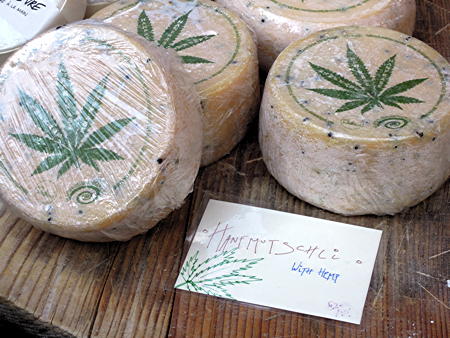Source: nytimes.com
By PATRICIA LEIGH BROWN

Charles Meyer, who farms 2,600 acres south of Fresno, Calif., is among a growing number of people who advocate legalizing the cultivation of industrial hemp. “The fact we’re not growing it is asinine,” Mr. Meyer said.
STRATFORD, Calif. — Charles Meyer’s politics are as steady and unswerving as the rows of pima cotton on his Central Valley farm. With his work-shirt blue eyes and flinty Clint Eastwood demeanor, he is staunchly in favor of the war in Iraq, against gun control and believes people unwilling to recite the Pledge of Allegiance should be kicked out of America, and fast.
But what gets him excited is the crop he sees as a potential windfall for California farmers: industrial hemp, or Cannabis sativa. The rapidly growing plant with a seemingly infinite variety of uses is against federal law to grow because of its association with its evil twin, marijuana.
“Industrial hemp is a wholesome product,” said Mr. Meyer, 65, who says he has never worn tie-dye and professes a deep disdain for “dope.”
“The fact we’re not growing it is asinine,” Mr. Meyer said.
Things could change if a measure passed by legislators in Sacramento and now on Gov.Arnold Schwarzenegger’s desk becomes law. [The bill reached Mr. Schwarzenegger last week; he has 30 days to sign or veto it.]
Seven states have passed bills supporting the farming of industrial hemp; their strategy has been to try to get permission from the Drug Enforcement Administration to proceed.
But California is the first state that would directly challenge the federal ban, arguing that it does not need a D.E.A. permit, echoing the state’s longstanding fight with the federal authorities over its legalization of medicinal marijuana. The hemp bill would require farmers who grow it to undergo crop testing to ensure their variety of cannabis is nonhallucinogenic; its authors say it has been carefully worded to avoid conflicting with the federal Controlled Substances Act.
But those efforts have not satisfied federal and state drug enforcement authorities, who argue that fields of industrial hemp would only serve as hiding places for illicit cannabis. The California Narcotic Officers Association opposes the bill, and a spokesman for the Office of National Drug Control Policy in Washington said the measure was unworkable.
Mr. Schwarzenegger, a Republican running for re-election, has been mum on his intentions, with the political calculus of hemp in California difficult to decipher. The bill was the handiwork of two very different lawmakers, Assemblyman Mark Leno, a San Francisco Democrat best known for attempting to legalize same-sex marriage, and Assemblyman Charles S. DeVore, an Orange County Republican who worked in the Pentagon as a Reagan-era political appointee.
Their bipartisan communion underscores a deeper shift in hemp culture that has evolved in recent years, from ragtag hempsters whose love of plants with seven leaves ran mostly to marijuana, to today’s savvy coalition of organic farmers and health-food entrepreneurs working to distance themselves from the drug.
Hundreds of hemp products, including energy bars and cold-pressed hemp oil, are made in California, giving the banned plant a capitalist aura. But manufacturers must import the raw material, mostly from Canada, where hemp cultivation was legalized in 1998.
The new hemp entrepreneurs regard it as a sustainable crop, said John Roulac, 47, a former campaigner against clear-cutting and a backyard composter before founding Nutiva, a growing California hemp-foods company. “They want to lump together all things cannabis,” said David Bronner, 33, whose family’s squeeze-bottle Dr. Bronners Magic Soaps, based in Escondido, Calif., are made with hemp oil. “You don’t associate a poppy seed bagel with opium.”
The differences between hemp and its mind-altering cousin, however, can be horticulturally challenging to grasp. The main one is that the epidermal glands of marijuana secrete a resin of euphoria-inducing delta-9 tetrahydrocannabinol, or T.H.C., a substance all but lacking in industrial hemp.
Ernest Small, a Canadian researcher who co-wrote a major hemp study in 2002 forPurdue University, compared the genetic differences to those that separate racehorses from plow horses. Evolution, Mr. Small said, has almost completely bred T.H.C. out of industrial hemp, which by law must have a concentration of no more than three-tenths of 1 percent.
To its supporters, industrial hemp is utopia in a crop. Prized not only for its healthful seeds and oils, rich in omega-3 and -6 fatty acids, but also its fast, bamboo-like growth that shades out weeds, without pesticides.
“Simply put, you create a jungle in one year,” said John LaBoyteaux, who testified in Sacramento on behalf of the California Certified Organic Farmers association. “There’s a growing market out there, and we can’t tap it.”
The bill before Governor Schwarzenegger is the latest installment in a hemp debate that reached its height in 2004, when the Ninth Circuit Court of Appeals said that federal antidrug laws did not apply to the manufacturing or consumption of industrial hemp. The court ruled that decades earlier, Congress had exempted from marijuana-control laws the stalks, fibers, oils and seeds of industrial hemp, and that the government had no right to ban hemp products.
That opened the floodgates for Patagonia hemp jeans and the Merry Hempsters Zit Zapper (with hemp oil).
Patrick D. Goggin, a lawyer for the Hemp Industries Association and Vote Hemp, said there would probably be legal snarls to work out with the California legislation, assuming it is enacted, so that farmers would not be placing their property in jeopardy if they chose to grow industrial hemp. But if the federal government clamps down, Mr. Goggin said, “we’re prepared to raise the issue in court.”
“We’re trying to get an arcane vision of the law contemporized,” he added.
Rogene Waite, a spokeswoman for the Drug Enforcement Administration, said the agency would not speculate about pending legislation.
The bill’s adherents point to hemp’s hallowed niche in American history. George Washington and Thomas Jefferson cultivated hemp (neither effort was profitable). Colonists’ boats sailed the Atlantic with hempen sails. Old Ironsides carried 60 tons of hempen sail and rope. The word “canvas,” in fact, is derived from cannabis, a high-tensile fiber naturally resistant to decay.
Hemp flourished as an American crop from the end of the Civil War until the 1937 Marihuana Tax Act ended production. During World War II, when Japan seized the Philippines and cut off supplies of Manila hemp, the crop got a brief reprieve in the United States, where farmers were encouraged to grow “Hemp for Victory,” for boots, parachute cording and the like. But contrary to lore, most such hemp was never harvested.
Today, China controls about 40 percent of the world’s hemp fiber, and its ability to flood the market “could result in price fluctuations the American farmer would have to weather,” said Valerie Vantreese, an agricultural economist in Lexington, Ky. (Kentucky was once the leading hemp-producing state).
Hemp is grown legally in about 30 countries, including many in the European Union, where it is mixed with lime to make plaster and as a “biocomposite” in the interior panels of Mercedes-Benzes.
In the United States, the chief argument against hemp has been made by drug-control officials, who are concerned that vast acreages could be used to conceal clandestine marijuana, which they say would be impossible to detect.
“California is a great climate to grow pot in, and no one from law enforcement is going through the fields to do a chemical analysis of different plants,” said Thomas A. Riley, a spokesman for the Office of National Drug Control Policy in Washington.
To some people intimate with the nuances of marijuana, however, the idea of hiding marijuana in a hemp field, where the plants would cross-pollinate, provokes amusement.
“It would be the end of outdoors marijuana,” said Jack Heber, 67, a marijuana historian and author who runs a group called Help End Marijuana Prohibition, or HEMP. “If it gets mixed with that crop, it’s a disaster.”
In North Dakota, the state agricultural commissioner, Roger Johnson, has proposed allowing hemp farming, and has been working with federal drug regulators on stringent regulations that would include fingerprinting farmers and requiring G.P.S. coordinates of hemp fields.
“We’ve done our level best to convince them we’re not a bunch of wackos,” Mr. Johnson said.
Fifteen years ago, he noted, there was little market for canola, which is now a major crop produced for its cooking oil. He sees hemp in a similar vein and dismisses the fears that it would lead to criminality.
But up north in Garberville, the Central Valley of marijuana, the lines between hemp and marijuana are often a hazy blur, as they are at a store called the Hemp Connection, where hemp hats and yoga clothing are sold alongside manuals on pot botany and Stoneware baking pans (“makes six groovy brownies per pan”).
The proprietor, Marie Mills, who said she once crafted paper from marijuana stalks, remains committed to cannabis in all its guises.
“We want to educate people and take away the stigma,” Ms. Mills said. “We want hemp without harassment.”












